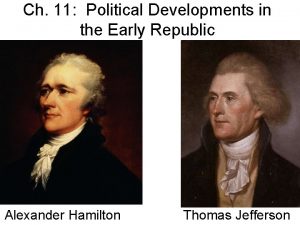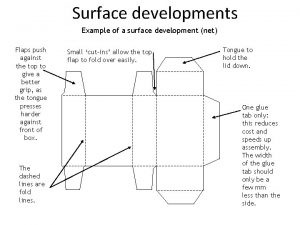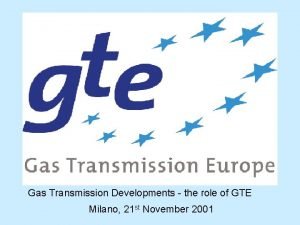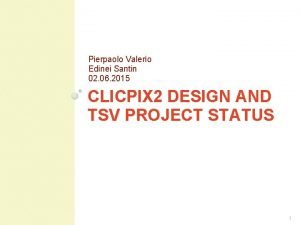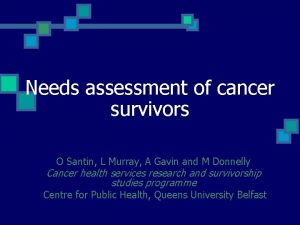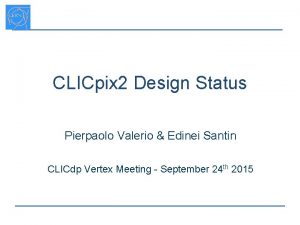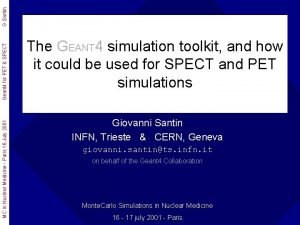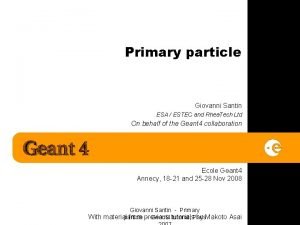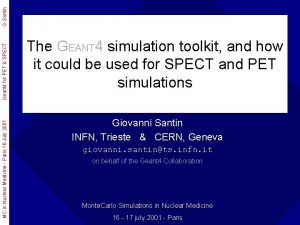Developments for Performance for Space Applications G Santin







![Geant 4 Reverse MC “Adjoint” technique [Kalos 1968] n New transport equation, “adjoint” to Geant 4 Reverse MC “Adjoint” technique [Kalos 1968] n New transport equation, “adjoint” to](https://slidetodoc.com/presentation_image_h2/c4e779fefedd999895fd838186ce428c/image-8.jpg)
- Slides: 8

Developments for Performance for Space Applications G. Santin for the Geant 4 Collaboration ESA / ESTEC Geant 4 Review G. Santin - Performance for CERN, 16 -20 April 2007 Space - Geant 4 Review, CERN,

n Several application domains in which Geant 4 performance can be an issue – Ground testing (accelerator, radioactive sources) – Space radiation environment spectra – Microdosimetry in big spacecraft structures n Geant 4 offers several variance reduction techniques (since several years) – Presented per application domain n Single particle (no collective effects) Parallel / distributed computing – Local cluster / GRID – TOP-C, DIANE, … n Present developments – More coherent VR framework to increase usability – Several new features (parallel geometries, more physics biasing, inverse MC, …) G. Santin - Performance for Space - Geant 4 Review, CERN, 16 -20 April 2007 2

Features by application domain (1/2) Ground testing of space devices n Accelerators (thin target) target – Cross section biasing • User implementations via G 4 VWrapper. Process • Hadronic physics • New Std EM developments – Forced interaction (implemented in HARP S/W) n Radioactive sources (soft spectrum, shielded sensitive volumes, late activation products) – RDM built-in biasing options • Decay branching ratios / nuclear splitting • Observation time window • Fast beta decay (“fbeta”) G. Santin - Performance for Space - Geant 4 Review, CERN, 16 -20 April 2007 3

Features by application domain (2/2) Space radiation environment spectra e. g. cosmic ray / solar / trapped radiation n Source biasing (GPS) – Position, Angular and Energy biasing – Multiple source biasing Big spacecraft structures (thick shield, micro -detectors) n Source biasing n Geometry biasing n Physics biasing (e. g. Brem splitting in e- environment) n Inverse Monte Carlo G. Santin - Performance for Space - Geant 4 Review, CERN, 16 -20 April 2007 4

Geant 4 Reverse MC n n n Space Engineering essential requirement Microdosimetry (electronics) from space environment in big structures Up to 102 precise calculations in ~ 1 hour (or less) – Dose, Flux, Single Event Effects n n New transport equation, “adjoint” to the conventional “forward” transport equation Transport analogous to the forward one, but backward – successive points are higher in energy, earlier in time Laurent Desorgher (Space IT) with ESA funding (REAT_MS 1 & 2) G. Santin - Performance for Space - Geant 4 Review, CERN, 16 -20 April 2007 5

Performance of the whole space application development cycle Installation, migrations n Layered software structure – CLHEP – GMDL – Histogramming Considering reducing number of dependencies Geometry interfaces n CAD (STEP) ESA REAT-MS project (Qineti. Q + subcontr. ) n Tessellated solids (triangular/quadrangular facets) Up to 105 – 106 facets per model ! Performance improvement under study (Qineti. Q, ESA) n GUI for geometry development (TRAD & eta_max, ESA) GDML output G. Santin - Performance for Space - Geant 4 Review, CERN, 16 -20 April 2007 6

Backup G. Santin - Performance for Space - Geant 4 Review, CERN, 16 -20 April 2007 7
![Geant 4 Reverse MC Adjoint technique Kalos 1968 n New transport equation adjoint to Geant 4 Reverse MC “Adjoint” technique [Kalos 1968] n New transport equation, “adjoint” to](https://slidetodoc.com/presentation_image_h2/c4e779fefedd999895fd838186ce428c/image-8.jpg)
Geant 4 Reverse MC “Adjoint” technique [Kalos 1968] n New transport equation, “adjoint” to the conventional “forward” transport equation n Transport analogous to the forward one, but backward – n n n successive points are higher in energy, earlier in time Suitable for Monte Carlo calculations Computations start at the detector and score at the source Possibility of computing doses at a point! Feasibility study (REAT_MS 1) Laurent Desorgher n Space IT and Uni. Bern n n G 4 RMC Prototype for fast e- dose computation Only continuous energy loss and simple multiple scattering Completed Full implementation (REAT_MS 2) n n RMC in G 4 for fast e- dose computation Backward simulation of : – e- ionisation with delta production, continuous energy loss and multiple scattering – Bremstrahlung, compton scattering, photo-electric effect n In development - Release mid 2007 Proposed to be included in Geant 4 release G. Santin - Performance for Space - Geant 4 Review, CERN, 16 -20 April 2007 8




